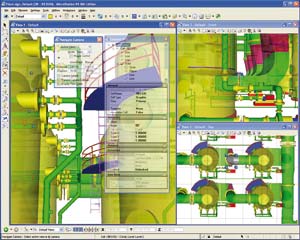Architectural practice John McAslan + Partners relied on MicroStation to develop this iconic station redevelopment that melds a Grade 1 listed building with state-of-the-art design.
Built in 1852, King’s Cross railway station is one of the main transportation hubs in London. As with the rest of the United Kingdom’s rail network infrastructure, the station has struggled in recent years to manage increasing passenger numbers and to provide the space and amenities commuters expect.
The £547 million redevelopment of King’s Cross station is at the heart of one of the largest regeneration projects in Europe, with 67 acres of brownfield land being redeveloped to create eight million square feet of offices, retail space and housing.
This complex urban regeneration project faced many technical challenges, including the potential impact on the mainline station, a number of underground transport connections, and the nearby St Pancras International railway station. The redevelopment also had to maintain the historic Grade 1 listed building, which required continual verification from English Heritage and other statutory bodies.
“King’s Cross station is not just a building; it is a major transportation node in a highly sensitive part of the city,” explains Cliff Green, project technology manager at John McAslan + Partners. “The way the station connects with the city and supports the urban regeneration project is hugely complex.”
For a project of this size and complexity, architects John McAslan + Partners needed equally sophisticated models and modelling tools. MicroStation’s federated model structure allowed the large design team to share common files between multiple disciplines. Using Bentley tools they were able to merge and organise numerous elements of the project including heritage and conservation work on current structures, as well as existing services and transportation infrastructure.
Remaking a London icon
The King’s Cross redevelopment project is operated by Network Rail and sponsored by the Department for Transport. The project required a new design and construction, reusing existing structures and restoring historic building elements, including the train shed and the station’s previously obscured historic faade.
Given the number of organisations involved in this complex project, from design through fabrication and construction, it was essential to enable efficient collaboration and information sharing. MicroStation’s federated model structure ensured everyone on this large design team had access to high-quality, consistent, validated data.
The collaborative process enabled the project team to avoid disruption to London Underground passengers and allowed Network Rail to meet its promise to TfL that no mainline train service would be cancelled due to redevelopment.
“With so much information to share with so many different parties, the speed and effectiveness of information capture and collaboration was a key aspect of this project,” Mr Green said.
3D modelling
The western concourse semi-circle diagrid roof, which rises 20 metres and spans 150 metres, involved engineering and co-ordination challenges.

The new concourse, which covers 7,500 square metres, and is the largest single-span structure in Western Europe, could only accommodate supports at a limited number of points, due to various subway and services tunnels. The roof also had to be constructed in a way that did not touch the historical structures. Accurate 3D modelling of the roof and surrounding structures was vital to successful co-ordination between an international team of architects, structural designers and fabricators.
Design verification
Because the station is an important historical structure, one of the key challenges for this project was the need for on-going design verification during the extended heritage and conservation negotiations. High-quality, accurate 3D models were vital to the restoration of the historic south facade, and the refurbishment of the vaulted main train shed (including incorporation of photo-voltaic arrays).
Using detailed survey data along with MicroStation’s power to handle complex infrastructure project data, John McAslan + Partners was able to weave historical structures into a modern project. “We were able to speed up the design process and could accurately predict the outcome of works to the existing historical fabric,” explains Mr Green. “It allowed savings during the construction phase through the reduction of errors in documentation and also for savings at scheme level by allowing rapid communication of the design to the client, consultative organisations and to project collaborators.”
The firm also used MicroStation to verify design concepts, for example assessing the way new buildings would work with the existing site and how the building’s flow would work for passengers, including everything from concourse layout to signage.
In addition, the concourse is now clad with 5.2 million tiny ceramic tiles that had to be laid over a two-way curve with construction joints. John McAslan + Partners used MicroStation to model each tile to assess how they could be best installed — a process that simply could not have been carried out manually.
Supportive technology
As the project progressed, John McAslan extended its use of Bentley software from 2D and 3D, to building information modelling (BIM) and GenerativeComponents, without the need to step outside the MicroStation interface. “This is a really smart way to work,” says Mr Green. “We can work in large teams and use 2D, 3D, and BIM to suit the state of the project, the type of project, and the skills of our team. The flexibility of MicroStation offers a real advantage and allows us to work to the best of our ability.”
The station remodel has enhanced passenger amenities, rationalised operational activities, and significantly increased retail space.
In addition, John McAslan + Partners played a key role in the wider transformation of the King’s Cross area. This included improved infrastructure, social, and commercial changes that now connect the station with the substantial King’s Cross Central scheme to the north, as well as improved interchange links with the London Underground, St Pancras station, Thameslink services, taxis and buses.
Images Courtesy of John McAslan + Partners
If you enjoyed this article, subscribe to AEC Magazine for FREE






